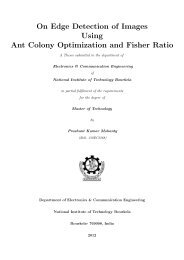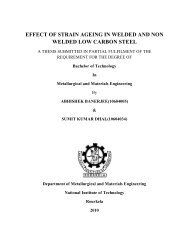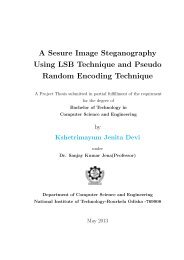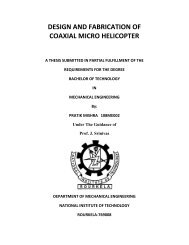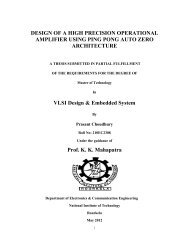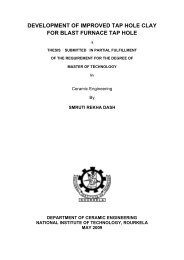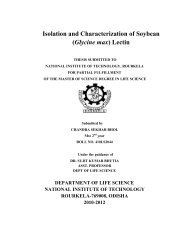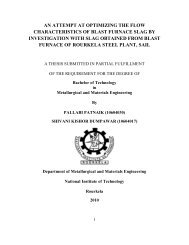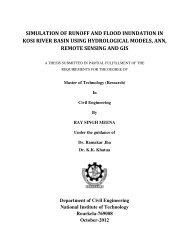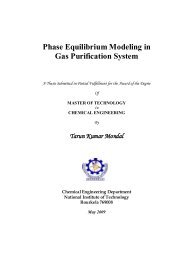analysis of transient heat conduction in different geometries - ethesis ...
analysis of transient heat conduction in different geometries - ethesis ...
analysis of transient heat conduction in different geometries - ethesis ...
You also want an ePaper? Increase the reach of your titles
YUMPU automatically turns print PDFs into web optimized ePapers that Google loves.
5.1 CONCLUSIONS<br />
CHAPTER 5<br />
CONCLUSIONS & SCOPE FOR FUTURE WORK<br />
An improved lumped parameter model is applied to the <strong>transient</strong> <strong>heat</strong> <strong>conduction</strong> <strong>in</strong> a long slab<br />
and long cyl<strong>in</strong>der. Polynomial approximation method is used to predict the <strong>transient</strong> distribution<br />
temperature <strong>of</strong> the slab and tube geometry. Four <strong>different</strong> cases namely, boundary <strong>heat</strong> flux for<br />
both slab and tube and, <strong>heat</strong> generation <strong>in</strong> both slab and tube has been analyzed. Additionally<br />
<strong>different</strong> temperature pr<strong>of</strong>iles have been used to obta<strong>in</strong> solutions for a slab. A unique number,<br />
known as modified Biot number is, obta<strong>in</strong>ed from the <strong>analysis</strong>. It is seen that the modified Biot<br />
number, which is a function <strong>of</strong> Biot number, plays important role <strong>in</strong> the transfer <strong>of</strong> <strong>heat</strong> <strong>in</strong> the<br />
solid. Based on the <strong>analysis</strong> the follow<strong>in</strong>g conclusions have been obta<strong>in</strong>ed.<br />
1. Initially a slab subjected to <strong>heat</strong> flux on one side and convective <strong>heat</strong> transfer on the other<br />
side is considered for the <strong>analysis</strong>. Based on the <strong>analysis</strong>, a closed form solution has been<br />
obta<strong>in</strong>ed.<br />
−Uτ<br />
⎛e + V ⎞<br />
θ = ⎜ ⎟<br />
⎝ U ⎠<br />
B<br />
Q<br />
U = V =<br />
1+<br />
B 1+<br />
B<br />
Where 3 , 3<br />
2. A long cyl<strong>in</strong>der subjected to <strong>heat</strong> flux on one side and convective <strong>heat</strong> transfer on the<br />
other side is considered for the <strong>analysis</strong>. Based on the <strong>analysis</strong>, a solution has been<br />
obta<strong>in</strong>ed.<br />
U =<br />
Where ( + B)<br />
−Uτ<br />
⎛e + V ⎞<br />
θ = ⎜ ⎟<br />
⎝ U ⎠<br />
B<br />
4 8<br />
53<br />
V =<br />
Q<br />
4 8<br />
, ( + B)<br />
3. A slab subjected to <strong>heat</strong> generation at one side and convective <strong>heat</strong> transfer on the other<br />
side is considered for the <strong>analysis</strong>. Based on the <strong>analysis</strong>, a closed form solution has been<br />
obta<strong>in</strong>ed.





